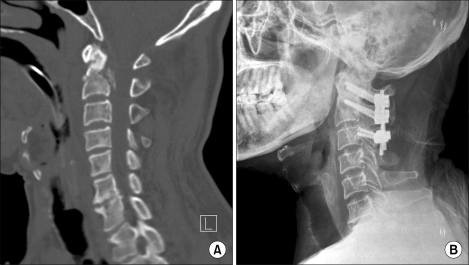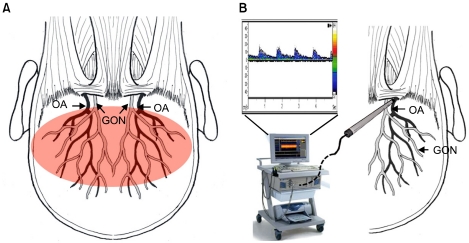Korean J Pain.
2011 Mar;24(1):48-52. 10.3344/kjp.2011.24.1.48.
A Case of Occipital Neuralgia in the Greater and Lesser Occipital Nerves Treated with Neurectomy by Using Transcranial Doppler Sonography: Technical Aspects
- Affiliations
-
- 1Department of Neurosurgery, Wonkwang University School of Medicine, Iksan, Korea. kseom@wonkwang.ac.kr
- KMID: 2278097
- DOI: http://doi.org/10.3344/kjp.2011.24.1.48
Abstract
- Occipital neuralgia is usually defined as paroxysmal stabbing pain in the greater or lesser occipital nerve (GON or LON) distribution. In occipital neuralgia patients, surgical considerations are carefully taken into account if medical management is ineffective. However, identification of the occipital artery by palpation in patients with thick necks or small occipital arteries can be technically difficult. Therefore, we established a new technique using transcranial Doppler (TCD) sonography for more accurate and rapid identification. The patient was a 64-year-old man who had undergone C1-C3 screw fixation and presented with intractable stabbing pain in the bilateral GON and LON distributions. In cases in which pain management was performed using medication, physical therapy, nerve block, or radiofrequency thermocoagulation, substantial pain relief was not consistently achieved, and recurrence of pain was reported. Therefore, we performed occipital neurectomy of the bilateral GON and LON by using TCD sonography, which helped detect the greater occipital artery easily. After the operation, the patient's headache disappeared gradually, although he had discontinued all medication except antidepressants. We believe that this new technique of occipital neurectomy via a small skin incision performed using TCD sonography is easy and reliable, has a short operative time, and provides rapid pain relief.
MeSH Terms
Figure
Cited by 1 articles
-
Sensory Complications in Patients after Scalp Mass Excision and Its Anatomical Considerations
Jin Seo Yang, Hyuk Jai Choi, Yong Jun Cho, Suk Hyung Kang
J Korean Neurosurg Soc. 2014;55(4):200-204. doi: 10.3340/jkns.2014.55.4.200.
Reference
-
1. Headache Classification Subcommittee of the International Headache Society. The international classification of headache disorders: 2nd edition. Cephalalgia. 2004; 24(Suppl 1):9–160. PMID: 14979299.2. Vanelderen P, Lataster A, Levy R, Mekhail N, van Kleef M, Van Zundert J. Occipital neuralgia. Pain Pract. 2010; 10:137–144. PMID: 20415731.
Article3. Sharma RR, Devadas RV, Pawar SJ, Lad SD, Mahapatra AK. Current status of peripheral neurectomy for occipital neuralgia. Neurosurg Q. 2005; 15:232–238.
Article4. Greher M, Moriggl B, Curatolo M, Kirchmair L, Eichenberger U. Sonographic visualization and ultrasound-guided blockade of the greater occipital nerve: a comparison of two selective techniques confirmed by anatomical dissection. Br J Anaesth. 2010; 104:637–642. PMID: 20299347.
Article5. Dubuisson D. Treatment of occipital neuralgia by partial posterior rhizotomy at C1-3. J Neurosurg. 1995; 82:581–586. PMID: 7897518.
Article6. Kapural L, Mekhail N, Hayek SM, Stanton-Hicks M, Malak O. Occipital nerve electrical stimulation via the midline approach and subcutaneous surgical leads for treatment of severe occipital neuralgia: a pilot study. Anesth Analg. 2005; 101:171–174. PMID: 15976227.
Article7. Stechison MT, Mullin BB. Surgical treatment of greater occipital neuralgia: an appraisal of strategies. Acta Neurochir (Wien). 1994; 131:236–240. PMID: 7754828.
Article
- Full Text Links
- Actions
-
Cited
- CITED
-
- Close
- Share
- Similar articles
-
- Fluoroscopy and Sonographic Guided Injection of Obliquus Capitis Inferior Muscle in an Intractable Occipital Neuralgia
- Diagnosis and treatment of occipital neuralgia: focus on greater occipital nerve entrapment syndrome
- Neuralgias of the Head: Occipital Neuralgia
- Clinical Outcomes of Pulsed Radiofrequency Neuromodulation for the Treatment of Occipital Neuralgia
- Occipital Neuralgia as the Only Presenting Symptom of Foramen Magnum Meningioma




